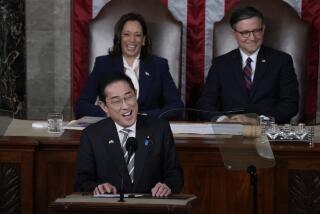Faces Hostility in Congress on Imbalance : Nakasone Arrives Today for Trade Talks
- Share via
TOKYO — Prime Minister Yasuhiro Nakasone will arrive in Washington today for the most crucial visit any Japanese leader has ever made to the United States.
His goal, Japanese diplomats say, is to prevent friction on trade issues from eroding the foundation of U.S.-Japan friendship and cooperation in fields ranging from security to international diplomacy.
In an effort to heal the wounds in Washington, Japan has already taken a series of recent steps described as the most sweeping in its history.
Time for Action Seen
Nakasone’s No. 1 problem, it appears, will be to persuade U.S. officials that Japan will carry through on the promises he plans to make. A number of U.S. officials have warned that the time has arrived for action, not promises.
Nakasone has been warned about the hostility that awaits him when he meets leaders of the Senate and House on Thursday and Friday after seeing President Reagan on both mornings.
“Rhetoric is escalating,” a Foreign Ministry official traveling with Nakasone said. “Facts and explanations no longer count. The basic point is the trade imbalance itself.”
Last year the U.S. trade deficit with Japan was $58.6 billion--and would have been even more if Japan had not routed $3 billion in gold through the United States to make it look as if Japan had imported the gold from the United States.
Barrage of Accusations
Japanese nerves too have become frayed by a barrage of American accusations, demands and charges of unfairness, while U.S. budget deficits have mounted and the competitiveness of American industry has been questioned.
If Congress enacts the protectionist measures it has threatened, Japanese feelings will be even stronger. Already, according to one diplomat, they have “reached the boiling point.”
Officials here said the “Ron and Yasu” relationship that Nakasone and Reagan have established in nine previous meetings will not be enough to hold back the tide in Congress. They pointed to Reagan’s diminished standing as a result of the Iran- contra scandal and the Democrats’ seizure of control in the Senate after last November’s elections.
“And, on top of that, the Administration itself has turned to taking measures against Japan,” one diplomat said.
Punitive Tariffs
He cited Reagan’s imposition, on April 17, of punitive tariffs on Japanese electronic goods in retaliation for Japan’s alleged failure to uphold an agreement on semiconductor trade signed last Sept. 2.
Nakasone has called the situation “distressing,” and it worsened Monday when Reagan, for the first time, urged Japan to open up its rice market and the dollar plunged to a new low in relation to the yen, 137.25 to 1.
Although the dollar bounced back from its Monday low, its continuing decline is forcing up interest rates in the United States and eroding the already reduced profits of Japanese manufacturers. As a result, Reagan and Nakasone are expected to discuss the exchange rate.
U.S. to Issue Bonds
The U.S. Treasury Department, which is scheduled to issue $28 billion in long-term bonds early next month, has reportedly approached the Japanese government with an informal request to persuade Japanese institutional investors, who have been shying away from dollar-denominated bonds, to buy their usual third of the issue.
In March, Japan’s net purchases of dollar securities plummeted to $3 billion, compared to an average of $10 billion in January and February, undermining demand for the Treasury notes and precipitating an increase in their interest rates as a result of the lower prices offered.
Late this afternoon, Foreign Minister Tadashi Kuranari, flying in ahead of Nakasone, is to give Secretary of State George P. Shultz a list of measures that Japan is prepared to take on individual issues ranging from tariffs on chocolate imports to purchases of American super computers.
Airport Bidding
Among the most politically charged of the issues expected to be brought up is the question of American access to bidding on equipment and services for a new, $7-billion Kansai (Osaka area) airport.
But concessions on such agricultural imports as beef and citrus will be conspicuously missing from the list. Last week, Nakasone told U.S. Trade Representative Clayton K. Yeutter that disputes over Japan’s restrictions on imports of farm goods were expected to be an issue “left over from my trip.”
Nakasone will tell the President that he will adopt--for the first time since he became prime minister in November of 1983--an aggressive policy aimed at expanding domestic demand by enacting a supplementary budget of more than 5 trillion yen ($35.7 billion), or 1.5% of last year’s gross national product.
Most Important Step
Reagan Administration officials, including Yeutter, said that meaningful moves to promote domestic demand constitute the most important step Japan can take to correct its global trade surplus of $92 billion.
A U.S. Embassy official in Tokyo, who asked not to be identified by name, said Washington realizes that expanding domestic demand in Japan will not significantly reduce America’s trade deficit, “but it will have some effect.”
More important, he said, is the fact that growth at home will facilitate structural adjustment by Japanese industries to develop more reliance on the domestic market rather than the export market. “It also would provide evidence that Japan is prepared to cooperate in its macro-economic policies,” he said.
With Japan’s present economic structure, growth of 1.5% in the GNP would bring in no more than $3.5 billion in imports, according to Yo Kurosawa, deputy president of the Industrial Bank of Japan. No more than half of this, or $1.7 billion, would come from the United States, he said.
More to Read
Sign up for Essential California
The most important California stories and recommendations in your inbox every morning.
You may occasionally receive promotional content from the Los Angeles Times.









